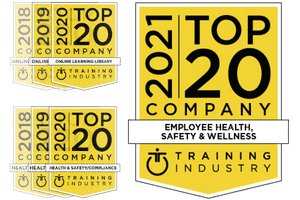If you are at all familiar with the training industry or general education, you have likely heard of microlearning. This concept of breaking down typical training topics into short, bite-sized modules has gained popularity in recent years, and for good reason.
In both our professional and social lives, technology truly surrounds us. Microlearning is an excellent way to harness the digital age, utilizing hyper-focused content and mobile-ready production to create a learning experience fitting of our time.
Microlearning can come in many forms, including short videos, PDFs, podcasts, games and infographics. It is commonly used for tangible skills, such as proper ladder use, since the limited time frame is not ideally suited for more conceptual topics.
What Are The Benefits of Microlearning?
Microlearning is not only about creating shorter training modules. Here are a few features that make microlearning ideal for any training program.
1. Mobile-ready content
It seems that everywhere you look, people are constantly on their phones. According to the Pew Research Center, 81% of Americans own a smartphone, up from 59% just five years ago. Offering short training courses optimized for use on smartphones or tablets makes the information easily accessible so learners can take training when it is convenient for them.
2. Addresses short attention spans
By now you have probably heard that our attention spans are roughly that of a goldfish. It makes sense, then, that shorter training videos better suit the reality of today’s learners. Microlearning courses get directly to the point without the “filler” content you often find in long lecture-style training courses.
3. Boosts knowledge retention
Along that same vein, microlearning also helps with knowledge retention as the course focuses only on what is truly necessary for that topic without the clutter of irrelevant information. Smaller, digestible pieces of content deliver the important information and nothing else, meaning you are much more likely to remember what you learned.
4. Fits into busy schedules
In addition to our short attention spans, the average employee also faces numerous external distractions throughout the workday. A study by the University of California-Irvine found that employees work for roughly 11 minutes before being interrupted by a phone call, an email or a co-worker stopping by. Microlearning offers very short bursts of content — often less than 10 minutes — making it easy to fit training in between other tasks.
GET STARTED WITH SAFETYSKILLS TODAY!
5. Can be standalone or part of a larger topic
With a shorter runtime, microlearning courses can act as standalone training for topics that do not require other corresponding training, such as Crane Safety – Hand Signals. However, microlearning can also be offered as shorter snippets of an in-depth topic. For instance, there are many types of personal protective equipment (PPE) employees need to be aware of. Each can be broken down into their own microlearning course, but they are best utilized together for comprehensive training.
6. More engaging
Because we have become a mobile-first society with shorter attention spans, it makes sense that our training needs to be fully engaging from beginning to end. Users are far more likely to stay present and engaged in a training video lasting 5-15 minutes than they are a full lecture that could last from 30 minutes to well over an hour.
7. Offers one objective at a time
While a typical training course introduces multiple learning objectives, a microlearning course deals with only one. This assures learners are able to fully grasp the concept at hand before moving on to the next. For instance, you could assign one 30-minute course on fire safety, or a series of microlearning courses covering alarms, evacuation, fire suppression and fire extinguisher use separately, ensuring full understanding of each.
8. Accessible for all generations
While the Millennial generation and a recent reliance on technology may have been the driving force toward this shift in learning trends, microlearning can apply to anyone. In fact, these smaller modules may be highly beneficial to older employees when faced with learning new concepts. Short bursts of training can help ease them into a new topic.
Get Started with Microlearning Today
As a leader in online safety training, SafetySkills is proud to offer an extensive course catalog that currently includes 350 microlearning titles. These courses cover some of the most common safety hazards and range from 3 minutes to 13 minutes.
Does that time frame seem short to you? Consider that the educational, informative and inspirational TED Talks have a program limit of 18 minutes for every speaker. TED organizers set that limit because they found it creates an ideally pared-down version of the topic. As TED curator Chris Anderson explains, “It has a clarifying effect. It brings discipline.”
See how SafetySkills can help you implement microlearning to create a more effective safety training program for your entire organization.


